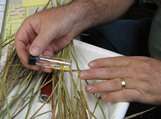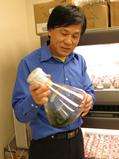Researchers explore fuel from algae, insects in native grasses

(Phys.org)—Fuel made from algae and the discovery of insects that no one has ever seen in native grasses were among the research findings presented by South Dakota State University researchers at the 2012 Sun Grant National Conference, Science for Biomass Feedstock Production and Utilization, Oct. 2-5, in New Orleans.
Vance Owens, interim director of the North Central Center of the Sun Grant Initiative, said that SDSU researchers covered the full range of topics from feedstock production to handling and processing. Sun Grant, funded through the U.S. Departments of Agriculture, Defense, Energy and Transportation, promotes collaboration among researchers from land-grant institutions, government agencies and the private sector to develop bio-based transportation fuels.
Ruanbao Zhou, associate professor of biology and microbiology, developed genetically manipulated blue-green algae called cyanobacteria to produce an alcohol called linalool. Zhou explained that linalool is a long-chain alcohol which has 10 carbon molecules; ethanol has only two carbon molecules. That difference translates to linalool having an energy density nearly identical to that of gasoline.
Linalool, which is used in perfumes, is a naturally occurring chemical in many flowers and plants such as mint. "We can smell the aroma of a flower or a pine tree because of the small amounts of linalool that these plants give off," Zhou said.
The microbiologist isolated the linalool-producing gene from the Norway spruce tree and inserted it into blue-green algae. The resulting cyanobacteria use sunlight, carbon dioxide and water to make starch, sugar and small amounts of linalool.
"The next step is to increase the productivity, to optimize the conditions to produce more linalool," Zhou said. To do this, Zhou must turn down the starch and sugar production to the level necessary to sustain the cyanobacteria and then channel the cells' energy into alcohol production.

Zhou envisions cyanobacteria factories as additions to ethanol plants. The rapidly growing algae, which can double in four hours, will use the huge amounts of carbon dioxide now emitted as a byproduct of ethanol production, an estimated 12.5 tons per second just in South Dakota.
Once the alcohol is harvested using techniques the ethanol producers already have, the fuel will be ready for use in vehicles. Unlike other plant materials, Zhou said, "we don't have to kill the algae to extract the product; they serve as a living fuel factory."
On the plant side of the biofuels scenario, Paul J. Johnson and Arvid Boe of the SDSU Plant Science Department have described previously unknown insects that exist in prairie cordgrass, switchgrass and cup plant. According to interim director Owens, their findings dispelled the misconception that these native plant species don't have many natural pests.
Because native grasses have not been explored as a crop since the late 1800s, Johnson said, "little has been published in the scientific literature since then."
"Biologists are at the very beginning stages of learning what insects and organisms associate with these plants," Johnson said. And judging by the numbers, their work has just begun.
Working with Ken Albrecht, a forage agronomist at the University of Wisconsin, Johnson and Boe, a grass breeder, have documented 30 different organisms within these ecosystems over a two-year period. Nearly two-thirds of these species found in South Dakota and Wisconsin have never been identified and catalogued, a process they have begun.
Though most of the organisms feed on the plants, Johnson said "only a few look to be economically important." In cup plant, for instance, the eucosma moth caterpillar damages the flowering plant's buds and then feeds on its roots, resulting in 100 percent flower and seed loss, and 50 percent biomass loss within a five-year period.
Some of the potential problems can be mitigated or solved by mixing the species of plants, Johnson said, "the greater the plant diversity, the greater the ecological stability." A species that might be a pest in a single-crop planting will not have a significant impact in a multi-species situation.
Because of these discoveries, engineers and chemists will likely need to develop processes that can break down multiple species of biomass at once.
Bringing researchers together to discuss these challenges is part of the Sun Grant's mission. As Owens said, "It takes investment to keep making this go forward and Sun Grant will continue to play a key role in building a bio-based economy."
Provided by South Dakota State University


















